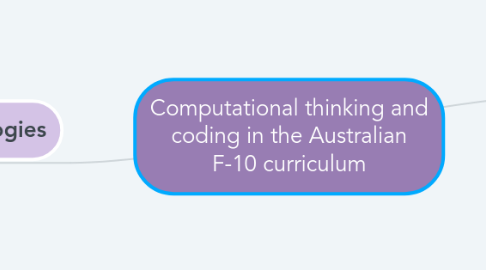
1. Technologies
1.1. Digital technologies
1.1.1. Computational thinking
1.1.1.1. Foundation-year 2
1.1.1.1.1. Follow, describe and represent a sequence of steps and decisions (algorithms) needed to solve simple problems (ACTDIP004)
1.1.1.2. Years 3 and 4
1.1.1.2.1. Define simple problems, and describe and follow a sequence of steps and decisions (algorithms) needed to solve them (ACTDIP010) Implement simple digital solutions as visual programs with algorithms involving branching (decisions) and user input (ACTDIP011)
1.1.1.3. years 5 and 6
1.1.1.3.1. Design a user interface for a digital system (ACTDIP018) Design, modify and follow simple algorithms involving sequences of steps, branching, and iteration (repetition) (ACTDIP019) Implement digital solutions as simple visual programs involving branching, iteration (repetition), and user input (ACTDIP020)
1.1.1.4. years 7-8
1.1.1.4.1. Define and decompose real-world problems taking into account functional requirements and economic, environmental, social, technical and usability constraints (ACTDIP027) Design algorithms represented diagrammatically and in English, and trace algorithms to predict output for a given input and to identify errors (ACTDIP029) Implement and modify programs with user interfaces involving branching, iteration and functions in a general-purpose programming language (ACTDIP030)
1.1.1.5. year 9-10
1.1.1.5.1. Define and decompose real-world problems precisely, taking into account functional and non-functional requirements and including interviewing stakeholders to identify needs (ACTDIP038) Design algorithms represented diagrammatically and in structured English and validate algorithms and programs through tracing and test cases (ACTDIP040) Implement modular programs, applying selected algorithms and data structures including using an object-oriented programming language (ACTDIP041)
2. Coding in the curriculum
2.1. Foundation- year 2
2.2. Years 3 and 4
2.2.1. Implement simple digital solutions as visual programs with algorithms involving branching (decisions) and user input (ACTDIP011)
2.2.2. Define simple problems, and describe and follow a sequence of steps and decisions (algorithms) needed to solve them (ACTDIP010)
2.3. Years 5 and 6
2.3.1. Implement digital solutions as simple visual programs involving branching, iteration (repetition), and user input (ACTDIP020)
2.3.2. Design a user interface for a digital system (ACTDIP018) Design, modify and follow simple algorithms involving sequences of steps, branching, and iteration (repetition) (ACTDIP019)
2.4. Year 7 and 8
2.4.1. Implement and modify programs with user interfaces involving branching, iteration and functions in a generalpurpose programming language (ACTDIP030)
2.4.2. Design the user experience of a digital system, generating, evaluating and communicating alternative designs (ACTDIP028) Design algorithms represented diagrammatically and in English, and trace algorithms to predict output for a given input and to identify errors (ACTDIP029)
2.5. Years 9 and 10
2.5.1. Implement modular programs, applying selected algorithms and data structures including using an object-oriented programming language (ACTDIP041)
2.5.2. Design the user experience of a digital system by evaluating alternative designs against criteria including functionality, accessibility, usability, and aesthetics (ACTDIP039) Design algorithms represented diagrammatically and in structured English and validate algorithms and programs through tracing and test cases (ACTDIP040)
